

|

Modern Dance Meets Centuries-Old Ritualized Combat.
By Margaret Regan
HOT AFRICAN RHYTHMS and Portuguese chants warmed the Orts
studio on a blustery day last week.
Two pairs of capoeiristas, practitioners of a centuries-old
African-Brazilian martial art, grappled with each other on the
dance floor. Moving to the beat of an atabaque (drum),
the four tramped around in circles, bended knees bringing them
low to the ground. After every full circle, they confronted each
other with sticks in a ritualized combat called jogo, and
the banging of stick against stick punctuated the percussive mix
of chant and drum. Meantime, three Orts dancers pivoted on trapezes
attached to the high ceiling, adapting their familiar movements--legs
pointed outward, backs curved--to the hypnotic beat.
 Modern dance was having a meeting of the minds with capoeira.
Modern dance was having a meeting of the minds with capoeira.
"There are a lot of parallels in the way the body is used
in an efficient sense (in the two forms)," Orts artistic
director Anne Bunker said when the rehearsal ended, and the panting
performers were stepping into street clothes. "They're both
from the earth. They both have a grounding and a centering of
the body."
Added capoeira teacher Dondi Marble, "Capoeira
has leg kicks, tumbles, cartwheels and a suspended line called
angola, just like the African country."
"Breaking Ground," a new collaborative piece by Bunker
and Marble that even last week wasn't completely nailed down,
will bring the electric mix of modern dance and capoeira to Tucson
audiences this weekend. A collaboration by Orts and Marble's Grupo
Capoeira Malandragem, the 34-minute work will be performed at
the PCC Center for the Arts Proscenium Theatre by eight Orts dancers,
seven capoeiristas and a half-dozen musicians on traditional
Afro-Brazilian instruments.
The new dance will be the second half of Urban Topography,
a concert that also will reprise "Urban Gaits," a mixed-media
performance piece about life in downtown Tucson. Put together
a year ago by five Tucson artists as an evening-length work, "Urban
Gaits" is equal parts music, dance, video and spoken word.
This year, the critically acclaimed piece will be a shorter version,
one that Bunker edited down for the company's trip last spring
to Costa Rica.
 Capoeirista Marble and Bunker first met through a mutual friend
about two years ago, back when Marble was "teaching in the
park at Fourth Avenue and had about 10 students." Bunker
invited him to offer classes in her studio, and now he's training
about 70 Tucsonans (including Bunker) in classes offered almost
every day. Marble, whose capoeira name is Professor Enxu,
learned the art from Mestre Acordeon, a Brazilian transplanted
to Berkeley. Devised hundreds of years ago by African slaves in
Brazil, capoeira is far more than the sum of its physical
movements, Marble said.
Capoeirista Marble and Bunker first met through a mutual friend
about two years ago, back when Marble was "teaching in the
park at Fourth Avenue and had about 10 students." Bunker
invited him to offer classes in her studio, and now he's training
about 70 Tucsonans (including Bunker) in classes offered almost
every day. Marble, whose capoeira name is Professor Enxu,
learned the art from Mestre Acordeon, a Brazilian transplanted
to Berkeley. Devised hundreds of years ago by African slaves in
Brazil, capoeira is far more than the sum of its physical
movements, Marble said.
"There's a whole philosophy and religion behind it. In Brazil,
the religion is a mix of African and Catholicism and it grew out
of that."
Initiations, for instance, are called batizados, and while
the ceremony looks nothing like the pouring of holy water on a
baby's head, devotees take a new name. Among the slaves, "it
was performed in different settings, for courtship, for battle,"
Marble said. "The training is dance-like and gymnastic but
the function is fighting. We perform it to make it look like a
dance, and to conceal its true function--conceal it from the slave
masters."
Capoeira prospered in the country's thick jungles and
mountains, in the remote camps of runaway slaves. Some of these
communities survived for decades, Marble said. When Brazil abolished
slavery in 1888, capoeira came to the cities with its practitioners.
"They did what they had to survive," Marble noted, and
the authorities, associating it with street crime, tried to suppress
it. Nowadays, capoeiristas study not only movement, but
history, the Portuguese language of its chants, and music.
 For the Orts concert, the Grupo musicians will play the berimbau,
a stringed instrument made from a gourd, along with drums, tambourines
and bells. A tape of the call-and-response capoeira songs
will alternate with composer Chuck Koesters' computer samplings
of the same music, a mix that mimics the fusion of modern dance
and capoeira on the stage.
For the Orts concert, the Grupo musicians will play the berimbau,
a stringed instrument made from a gourd, along with drums, tambourines
and bells. A tape of the call-and-response capoeira songs
will alternate with composer Chuck Koesters' computer samplings
of the same music, a mix that mimics the fusion of modern dance
and capoeira on the stage.
"In 'Bridging Worlds,' the way we did it, the capoeiristas
are the human element," said Bunker. "The dancers are
the jungle, the flora, fauna and animals. It's like the merging
of two different worlds, but we respond and react to each other."
Orts Theatre of Dance presents Urban Topography
at 8 p.m. Friday and Saturday, November 20 and 21, at the PCC
Center for the Arts Proscenium Theatre, 2202 W. Anklam Road. "Bridging
Worlds" is a collaboration between Orts and the Grupo Capoeira
Malandragem. "Urban Gaits" is a collaboration among
Bunker, Koesters, Nancy Solomon, Charles Alexander and Cynthia
Miller. Tickets at the door are $12 for adults, $8 for seniors
and students; kids 14 and under are free with a paying adult.
Advance tickets, $10 and $8, are available from Orts via e-mail,
at orts@rtd.com, and at Antigone Books, Bentley's and Silverbell
Trading. For more information, call 624-3799.

|
 |





